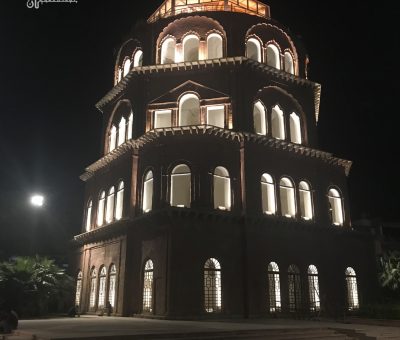
The fine subtlety and grandeur of the historical monuments built by the Nawabs of Lucknow, coupled with the glorious past of the city have influenced many historians and writers to acknowledge Lucknow as the “Constantinople of the East.” The old city area of Lucknow is replete with historical monuments so much so that it seems to be taken straight out of a history book. Most of the monuments built by the Nawabs of Awadh portray a rich blend of Mughal, British, and Persian architecture at its best. One such magnificent structure, which unfortunately could not reach completion, is the Satkhanda, situated in the Hussainabad area of the city. Satkhanda, which is considered a unique monument built under the reign of Nawab Mohammad Ali Shah, commands admiration and respect from visitors across the world. The distinctive architectural design and grandeur of Satkhanda is going unnoticed as its condition is deteriorating due to lack of attention from the Archaeological Survey of India (ASI) and the state governments in the past that did nothing to save this heritage monument.
History of Satkhanda
The word “Satkhanda” literally signifies seven-storeyed. The tower was built by Nawab Mohammad Ali Shah in 1842. Originally, the plan was to build 30 meters high, seven-storey tower but the construction work was abandoned after the untimely death of Nawab Mohammad Ali Shah. By that time, only four storeys could be completed. Satkhanda, though incomplete, was built by integrating the rich features of Mughal, Greek, and French architecture into one. The architectural design of the tower seems to be somewhat influenced by the Leaning Tower of Pisa and the Qutub Minar at Delhi. The tower is approximately 21 meters high and was built to view the moon by the Ulema (clerics) as Muslims celebrate Eid, Bakreed and other Islamic festivals according to the sighting of the moon. Moreover, Nawab Mohammad Ali Shah wanted to have an extensive bird’s eye view of the wonderful city of Lucknow along with the majestic monuments and buildings from Satkhanda. According to some local historians, the Nawab used to love his daughter immensely and wanted to build the monument for her. Unfortunately, the Nawab’s daughter is said to have died at a tender age. Soon after the untimely death of his daughter, Nawab Mohammad Ali Shah also died as he was unable to bear the loss of his daughter. The construction of the Satkhanda tower was abruptly stopped after the death of Nawab Mohammad Ali Shah and the descendants of the Nawab did not undertake the completion of the construction because they thought it would be a bad omen. Some locals believe that Nawab Mohammad Ali Shah hurt his ankle badly while climbing the stairs of the tower and died soon after this incident. Perhaps, this was the reason behind the reluctance of the Nawab’s descendants to avoid resuming the construction of Satkhanda, considering it a bad omen.
Architecture of Satkhanda
The tower is made from red bricks incorporating fine subtleties of Mughal, Greek, and French architecture. The architectural pediments and framework of Satkhanda seems to have been influenced by the delicate Greek structural design while the arches of windows and gates depict Mughal and French designs. The octagonal-shaped ground floor of the tower stands tall at 20 feet, thus making it the tallest floor of the tower. The unique architectural feature of Satkhanda is that every successive level in the tower has been built in the reducing order of width and height when compared with the base (ground) floor. The Satkhanda stands tall at approximately 68 feet and has many beautiful triple-arched partitions and windows. A beautiful arrangement of spiral steps actually leads to all the different storeys of the tower. From the top floor, visitors can see and explore the beauty of Lucknow and adjacent area comprising the magnificent Bada Imambara, Chhota Imambara, Ghanta Ghar, Rumi Darwaza, and Hussainabad Picture Gallery to name a few.
The present state of Satkhanda
The heritage monument was deteriorating rapidly due to the apathy of the concerned authorities but interference by some local NGOs and media prompted the Hussainabad Trust and Archaeological Survey of India to up the renovation work at the tower. Now, after the restoration has been completed, the heritage monument embodies its rich past and stands tall basking in its reclaimed glory. So, if you have an eye for the places less travelled, Satkhanda can offer you a reason to satiate your travel expectations from the city of Nawabs. It is none the less a popular destination with tourists out on a tour to visualize the architectural ambitions of the Nawabs of Awadh.


Comment here